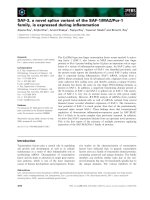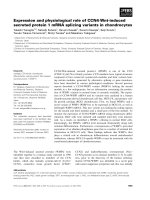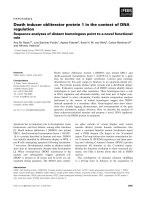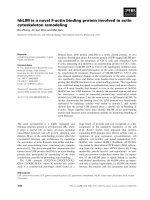STARCH-BINDING DOMAIN-CONTAINING PROTEIN 1: A NOVEL PARTICIPANT IN GLYCOGEN METABOLISM
Bạn đang xem bản rút gọn của tài liệu. Xem và tải ngay bản đầy đủ của tài liệu tại đây (4.57 MB, 152 trang )
STARCH-BINDING DOMAIN-CONTAINING PROTEIN 1:
A NOVEL PARTICIPANT IN GLYCOGEN METABOLISM
Sixin Jiang
Submitted to the faculty of the University Graduate School
in partial fulfillment of the requirements
for the degree
Doctor of Philosophy
in the Department of Biochemistry & Molecular Biology
Indiana University
June 2011
ii
Accepted by the Faculty of Indiana University, in partial
fulfillment of the requirements for the degree of Doctor of Philosophy.
___________________________________
Peter J. Roach, Ph.D., Chair
Doctoral Committee
___________________________________
Anna A. DePaoli-Roach, Ph.D.
March 24, 2011
___________________________________
Robert A. Harris, Ph.D.
___________________________________
Nuria Morral, Ph.D.
iii
DEDICATION
This work is dedicated to my parents, Zhanyan Jiang and Zongshu Liu, whose
unconditional love and constant support have given me strength to face all the
challenges in life.
This work is also dedicated to my grandparents, who always had faith in me.
.
iv
ACKNOWLEDGEMENTS
First of all, I would like to express my sincere gratitude toward my mentor, Dr.
Peter Roach who has been supported me with knowledge, inspiration and
valuable advice. He truly encouraged me and guided me with all his patience to
be an independent scientist as well as a critical thinker. Throughout these years,
he has taught me more than science and I appreciate it with all my heart.
I would like to thank my committee members, Dr. Anna DePaoli-Roach, Dr.
Robert Harris and Dr. Nuria Morral, for all of their brilliant advice and insightful
discussion about my projects as well as their warm encouragement. They
helped me grow. I am greatly inspired by all their passion and scientific wisdom.
I would like to thank everyone who I worked with, current and past, in the Roach
and DePaoli-Roach labs. Dr. Alexander Skurat, Lanmin Zhai, Dr. Wei Wang, Dr.
Julia Degler, Dr. Vincent Tagliabracci, Dr. Jose Irimia, Cathy Meyer, Dyann
Segvich, Chandra Karthik, Christopher Contreras, Punitee Garyali , Dr. Chiharu
Nakai, Katrina Hughes, Jennifer Gleissner, Caron Peper, Dr. Gretchen Parker
and Amanda McGuire. I am grateful to having them not only as my colleagues
but also as my friends. It was a great pleasure working and spending time with
all of them.
I would like to thank our neighbor and collaborator Dr. Clark Wells and everyone
in his lab, Brigitte Heller, Bill Ranahan, Jacob Adler and Whitney Smith. They all
v
helped me through immunofluorescence microscopy and they made work fun. I
would like to thank Dr. Keith Condon for helping me with histology. I would like to
thank everyone in the Department office of Biochemistry and Molecular Biology.
And finally, I would like to thank my family and friends who have always been
there for me.
vi
ABSTRACT
Sixin Jiang
STARCH-BINDING DOMAIN-CONTAINING PROTEIN 1:
A NOVEL PARTICIPANT IN GLYCOGEN METABOLISM
Glycogen, a branched polymer of glucose, acts as an intracellular carbon and
energy reserve in many tissues and cell types. The breakdown of glycogen by
hormonally regulated degradation involving the coordinated action of glycogen
phosphorylase and debranching enzyme has been well studied. However, the
importance of lysosomal disposal of glycogen has been underscored by a
glycogen storage disorder, Pompe disease. This disease destroys tissues by
over-accumulating glycogen in lysosomes due to a genetic defect in the
lysosomal acid α-glucosidase. Details of the intracellular trafficking of glycogen
are not well understood. Starch-binding domain-containing protein 1 (Stbd1) is a
protein of previously unknown function with predicted hydrophobic N-terminus
and C-terminal CBM20 carbohydrate binding domain. The protein is highly
expressed in the liver and muscle, the major repositories of glycogen. Stbd1
binds to glycogen in vitro and in vivo with a preference for less branched and
more phosphorylated polysaccharides. In animal models, the protein level of
Stbd1 correlates with the genetic depletion of glycogen. Endogenous Stbd1 is
found in perinuclear compartments in cultured mouse and rat cells. When over-
expressed in cells, Stbd1 accumulates and coincides with glycogen and
GABARAPL1, the autophagy protein. They form enlarged perinuclear structures
which are abolished by removing the hydrophobic N-terminus of Stbd1. Stbd1,
vii
with point mutations in the CBM20 domain, retains the perinuclear localization
but without concentration of glycogen in this compartment. In cells that are
stably over-expressing glycogen synthase, glycogen exists as large perinuclear
deposits, where Stbd1 can also be present. Removing glucose from the culture
leads to a breakdown of the massive glycogen accumulation into numerous
smaller and scattered deposits which are still positive for Stbd1. Furthermore,
the autophagy protein GABARAPL1 co-immunoprecipates and co-localizes with
Stbd1 when co-expressed in cells. Point mutation or deletion of the autophagy
protein interacting region on Stbd1 eliminates the interaction and co-localization
with GABARAPL1 but not the characteristic perinuclear distribution of Stbd1. We
propose that Stbd1 is involved in glycogen metabolism. In particular, it
participates in the vesicular transfer of glycogen to the lysosome with the
recruitment of autophagy related proteins GABARAPL1 and/or GABARAP, as
these vesicles mature prior to lysosomal fusion.
Peter J. Roach, Ph.D., Chair
viii
TABLE OF CONTENTS
1. Glycogen and its metabolism 1
1.1 Glycogen structure and function 1
1.2 Subcellular distribution of glycogen 4
1.3 Glycogen metabolism 4
1.3.1 Glycogen synthesis 6
1.3.1.1 Glycogenin (GN) 7
1.3.1.2 Glycogen synthase (GS) 7
1.3.1.3 The branching enzyme (BE) 9
1.3.2 Glycogen degradation 10
1.3.2.1 Glycogen phosphorylase (GPh) 10
1.3.2.2 The debranching enzyme (DBE) 11
1.3.2.3 Acid-α-glucosidase (GAA) 12
1.4 Regulation of glycogen metabolism 12
1.4.1 Regulation in skeletal muscle 12
1.4.2 Regulation in the liver 14
2. Diseases associated with glycogen metabolism 15
2.1 Glycogen storage disease type 0: Glycogen synthase deficiency 15
2.2 Glycogen storage disease type I: von Gierke’s disease;
Glucose-6-phosphatase deficiency; Hepatorenal glycogenosis 16
2.3 Glycogen storage disease type II: Pompe disease;
Acid α-glucosidase deficiency; Acid maltase deficiency;
α-1, 4-glucosidase deficiency 16
2.4 Glycogen storage disease type III: Cori disease; Forbes disease;
Amylo-1,6-glucosidase deficiency; Glycogen debrancher deficiency 18
2.5 Glycogen storage disease type IV: Andersen’s disease; Brancher
deficiency; Amylopectinosis; Glycogen branching enzyme deficiency 18
LIST OF TABLES xii
LIST OF FIGURES
xiii
LIST OF ABBREVIATIONS
xv
INTRODUCTION
1
ix
2.6 Glycogen storage disease type V: McArdle’s disease;
Myophosphorylase deficiency; Muscle glycogen phosphorylase
deficiency 19
2.7 Glycogen storage disease type VI: Hers disease; Liver glycogen
phosphorylase deficiency 19
2.8 Glycogen storage disease type VII: Tarui disease; Muscle
phosphofructokinasedeficiency; Glycogen storage disease of muscle 19
2.9 Phosphorylase activation system defects: Phosphorylase kinase
system defects; GSD-VIa, IX, X, or VIII) 20
2.10 Glycogen storage disease type XI: GSD-XI; Fanconi-Bickel
Syndrome, FBS 20
2.11 Lafora disease 21
3. Carbohydrate-binding modules 21
3.1 Carbohydrate-binding module families 21
3.2 Starch-binding domain 26
3.2.1 CBM20 26
3.2.2 CBM21, CBM48 and CBM 53 29
3.2.3 CBM25, CBM26, CBM34, CBM41 and CBM45 29
4. Starch-binding domain-containing protein 1 31
5. Autophagy 33
5.1 Macroautophagy 35
5.1.1 Omegasome formation 35
5.1.2 Initiation and elongation of isolation membrane 36
5.1.3 Autophagosome formation 36
5.1.4 Function 39
5.2 Microautophagy 39
5.3 Chaperone-mediated autophagy 40
5.4 Selective autophagy 40
6. Atg8 family 42
6.1 Microtubule-associated protein 1A/1B-light chain 3
(MAP1-LC3 or LC3) 42
x
6.2 γ-Aminobutyric acid (GABA)
A
receptor-associated protein
(GABARAP) 43
6.3 GABARAP-like 1 (GABARAPL1) 44
6.4 GABARAP-like 2 44
6.5 Atg8 family interacting motif and the docking site 45
1. Yeast two hybrid screen 48
1.1 Yeast transformation (lithium-acetate method) 48
1.2 Isolation of yeast DNA 49
1.3 Rescue of plasmid in E. coli RRI cells by electroporation 49
1.4 E-galactosidase activity assay 51
2. Plasmid construction 51
3. Ligation, transformation and plasmid preparation 52
4. Mutagenesis 53
6. Glycogen purification and polysaccharide binding assay 61
7. Antibodies 62
8. Cell culture and transfections 62
9. Preparation of tissue and cell extracts and immunoblotting 63
10. Co-immunoprecipitation 64
11. Immunofluorescence staining and microscopy 64
12. Immunohistochemistry 65
13. Periodic acid-Schiff reagent (PAS) staining and microscopy 66
14. Glycogen assay 66
15. RNA isolation and quantitative PCR 67
16. Statistical Analysis 67
1. Association of Stbd1 with polysaccharides 68
1.1 Stbd1 binds glycogen and amylopectin in vitro 68
1.2 Stbd1 interacts with glycogen in muscle extract 71
1.3 Endogenous Stbd1 distribution in mouse tissues 71
RESEARCH OBJECTIVE 47
EXPERIMENTAL PROCEDURES
48
RESULTS 68
xi
1.4 Correlation of Stbd1 with glycogen levels in different
genetically modified mice 73
2. Structure-function analysis of Stbd1 76
2.1 Sequence analysis 76
2.2 Detection of endogenous Stbd1 in cell lines 79
2.3 Structure and function analysis by study of hStbd1-HA and
mutants 81
2.4 Glycogen association of Stbd1 in cells and study of glycogen
binding site on Stbd1 85
3. Stbd1 interacting proteins 91
3.1 Interaction of Stbd1 with GABARAPL1 and/or GABARAP 91
3.1.1 Confirmation of interaction 91
3.1.2 Identification of Atg8 family interacting motifs on Stbd1 96
3.2 Potential interaction between Stbd1 and laforin 98
1. Involvement of Stbd1 in glycogen metabolism 107
2. Stbd1 as a selective autophagic adaptor for glycogen disposal 109
CURRICULUM VITAE
DISCUSSION 107
REFERENCES 113
xii
LIST OF TABLES
Table 1. CBMs classification based on structure (fold). 23
Table 2. Glycogen content in different mouse tissues. 72
xiii
LIST OF FIGURES
Figure 1. Glycogen structure and glycosidic linkages. 3
Figure 2. Schematic model of Glycogen metabolism. 5
Figure 3. Structures of CBMs classified into three types by functional
similarity [133]. 24
Figure 4. The structural features of SBD from individual CBM families [141]. 30
Figure 5. Structures of conserved SBDs [163] 32
Figure 6. Schematic models of three forms of autophagy. 34
Figure 7. Schematic models of ubiquitin-like conjugation system for
autophagosome formation in yeast. 38
Figure 8. Sequence alignment of reported AIMs and their interacting Atg8
family proteins [213]. 45
Figure 9. Yeast two hybrid screen. 50
Figure 10. Plasmid construction map of mammalian expression plasmids
containing human STBD1 with C-terminal HA tag in different lengths. 55
Figure 11. Plasmid construction map of E. coli expression plasmids
containing mouse Stbd1. 56
Figure 12. Plasmid construction map of mammalian expression plasmids
containing human GABARAP or GABARAPL1 57
Figure 13. Site-directed mutegenesis. 58
Figure 14. Schematic architecture of human Stbd1 and mutants. 60
Figure 15. Association of Stbd1 protein with glycogen. 70
Figure 16. Endogenous distribution of Stbd1 protein in mouse tissues. 72
Figure 17. Correlation of Stbd1 protein level with genetic modified glycogen
level in mice. 74
Figure 18. mRNA level of Stbd1 in liver and muscle. 75
Figure 19. Sequence alignment of mammalian Stbd1. 78
Figure 20. Stbd1 clones of different lengths identified by C-terminal half of
Stbd1 in yeast two hybrid screen. 78
Figure 21. Endogenous Stbd1 in mouse and rat cells. 79
xiv
Figure 22. Subcellular localization of endogenous Stbd1 with respect to
organelle markers in FL83B and Rat1Neo5 cells. 80
Figure 23. Subcellular localization of Stbd1. 83
Figure 24. Subcellular localization of Stbd1 over-expressed in COS M9
cells with respect to organelle markers. 84
Figure 25. Co-localization of Stbd1 with glycogen in Rat1 cells. 87
Figure 26. Point mutational analysis of Stbd1 expressed in COS M9 cells. 88
Figure 27. Detection of glycogen in COSM9 cells with or without
overexpressing Stbd1. 89
Figure 28. Co-localization of Stbd1 with glycogen in COS cells. 90
Figure 29. Interaction of Stbd1 with GABARAPL1 and GABARAP 93
Figure 30. Subcellular localization of GABARAPL1, GABARAP and LC3 in
relation to Stbd1. 95
Figure 31. Schematic architecture of human Stbd1 with potential AIMs. 99
Figure 32. Interaction of GABARAPL1 with truncated mutants of Stbd1. 99
Figure 33. Mutational analysis of Atg8 family interacting motif (AIM) on
Stbd1 expressed in COS M9 cells. 100
Figure 34. Interaction of GABARAPL1 with Stbd1 and potential Atg8 family
interacting motif (AIM) mutants of Stbd1. 101
Figure 35. Subcellular localization of GABARAPL1 and Atg8 family
interacting motif (AIM) mutants of Stbd1 co-expressed in COS M9 cells. 102
Figure 36. Subcellular localization of GABARAPL1 and single mutants of
Stbd1 co-expressed in COS M9 cells. 104
Figure 37. Subcellular localization of endogenous GABARAPL1 and
overexpressed Stbd1 with Atg8 family interacting motif (AIM) mutations in
COS M9 cells. 105
Figure 38. Working model. 112
xv
LIST OF ABBREVIATIONS
A/Ala Alanine
ADP Adenosine diphosphate
AGL Amylo-1,6-glucosidase, 4-α-glucanotransferase
AIM Atg8 family interacting motif
Ams α-mannosidase
AMP Adenosine monophosphate
AMPK AMP activated protein kinase
Ape1 aminopeptidase 1
ATG Autophagy-related genes
ATP Adenosine triphosphate
BE Branching enzyme
BNIP3 BCL2/adenovirus E1B 19 kDa protein-interacting protein 3
BNIP3L BNIP3-like
BRCA1 Breast cancer 1
C/Cys Cysteine
CaCl
2
Calcium chloride
CALCOCO2 Calcium binding and coiled-coil domain 2
cAMP 3'-5'-cyclic adenosine monophosphate
CAZy Carbohydrate active enzymes
CBM Carbohydrate-binding module
CGTase Cyclodextrin glucanotransferase
CHCl
3
Chloroform
CHC Clathrin heavy chain
CK-1 Casein kinase-1
CK-2 Casein kinase-2
CRT Calreticulin
Cvt cytoplasm-to-vacuole targeting pathway
D/Asp Aspartic acid
Da Dalton
DAB 3,3'-diaminobenzidine
xvi
DBE Glycogen debranching enzyme
ddH
2
O Double-distilled water
DFCP1 double FYVE-domain containing protein 1
DNA Deoxyribonucleic acid
DSP Dual specificity phosphatase
DTT Dithiothreitol
DYRK1A Dual specificity tyrosine-phosphorylation-regulated
kinase 1A
E/Glu Glutamic acid
EDTA Ethylenediaminetetraacetic acid
EGTA Ethyleneglycol-O, O'-bis(2-aminoethyl)-N, N, N', N'-
tetraacetic acid
EM Electron microscopy
Epm2a Epilepsy progressive myoclonus type 2a
Epm2b Epilepsy progressive myoclonus type 2b
ER Endoplasmic reticulum
F/Phe Phenylalanine
F6P Fructose-6-phosphate
F-1,6-BP Fructose-1,6-bisphosphate
FIP200 Focal adhesion kinase family interacting protein of 200 KDa
G/Gly Glycine
G1P Glucose-1-phosphate
G6P Glucose-6-phosphate
G6Pase Glucose-6-phosphatase
G6PDH Glucose-6-phosphate dehydrogenase
G6PT Glucose-6-phosphate translocase
GA Glucoamylase
GAA Lysosomal acid-α-glucosidase
GABA γ-Aminobutyric acid
GAGARAP (GABA)
A
receptor-associated protein
GABARAPL1 GABARAP-like 1
xvii
GABARAPL2 GABARAP-like 2
GABRG2 (GABA)
A
receptor γ-2S subunit
GAPDH Glyceraldehyde-3-phosphate dehydrogenase
GEC1 Glandular epithelial cell protein 1
GH Glycoside hydrolase
GLUT Sodium independent glucose transporter
GN Glycogenin
GPh Glycogen phosphorylase
GS Glycogen synthase
GSK3 Glycogen synthase kinase-3
GSD Glycogen storage disease
GWD Glucan, water dikinase
H
2
O Water
H
2
O
2
Hydrogen peroxide
HCl Hydrochloric acid
HClO
4
Perchloric acid
HCIP High-confidence candidate interaction proteins
HK Hexokinase
H
2
SO
4
Sulfuric acid
HRP Horseradish peroxidase
HSS High speed supernatant
HSP High speed pellet
IAA Isoamyl alcohol
I/Ile Isoleucine
IR Insulin receptor
IRS Insulin receptor substrate
kDa Kilodalton
KH
2
PO
4
Potassium dihydrogen phosphate
KOH Potassium hydroxide
L/Leu Leucine
LAMP Lysosome-associated membrane protein
xviii
LB Lysogeny broth
LC3/MAP1LC3 Microtubule-associated protein 1 light chain 3
LD Lafora disease
LiAc Lithium acetate
LiCl Lithium chloride
LIR LC3 interacting region
LSS Low speed supernatant
LSP Low speed pellet
MEF Mouse embryonic fibroblast
MgCl
2
Magnesium chloride
MgSO
4
Magnesium sulfate
MGSKO Muscle glycogen synthase knockout
NaCl Sodium chloride
Na
2
CO
3
Sodium carbonate
Na
2
HPO
4
Sodium phosphate, dibasic
NaH
2
PO
4
Sodium phosphate, monobasic
NADP
Nicotinamide adenine dinucleotide phosphate
NaOAc Sodium acetate
NBR1 Next to BRCA1 gene 1 protein
NDP52 Nuclear dot protein of 52 kDa
NH
4
HCO
3
Ammonium bicarbonate
NH
4
OH Ammonium hydroxide
(NH
4
)
2
SO
4
Ammonium Sulphate
NHLRC1 NHL repeat-containing protein 1
NIP3 BNIP3
Nix NIP3-like protein X
NMR Nuclear magnetic resonance
NSF N-ethylmaleimide sensitive fusion protein
OH Hydroxyl
PAS Periodic acid-Shiff;
Phagophore-assembly site or pre-autophagosome structure
xix
PCR Polymerase chain reaction
PDK-1 Phosphoinositide-dependent kinase-1
PE phosphatidylethanolamine
PEG Polyethylene glycol
PFK Phosphofructokinase
PGI Phosphoglucose isomerase
PGM Phosphoglucomutase
Ph Phosphorylase
PhK Phosphorylase kinase
PI(3)P Phosphatidylinositol-3-phosphate
PI(4,5)P2 Phosphatidylinositol-(4,5)-bisphosphate
PI(3,4,5)P3 Phosphatidylinositol-(3,4,5)-triphosphate
PKA cAMP dependent protein kinase / protein kinase A
PI3K Phosphatidylinositol-3-kinase
PKB/Akt Protein kinase B
PM Plasma membrane
PMSF Phenylmethylsulfonylfluoride
PP1c Catalytic subunit of protein phosphatase 1
PP1G Glycogen associated protein phosphatase 1
PTG Protein targeting to glycogen
R
GL
/G
M
Regulatory subunit of protein phosphotase 1, muscle isoform
RNA Ribonucleic acid
RT Room temperature
RT-PCR Reverse transcription polymerase chain reaction
S/Ser Serine
SBD Starch-binding domain
SDS Sodium dodecyl sulfate
SDS-PAGE Sodium dodecyl sulfate polyacrylamide gel electrophresis
SEX4 Starch excess 4 protein
SM Skeletal muscle
SQSTM1 Sequestosome protein-1, p62
xx
SR Sarcoplasmic reticulum
Stbd1 Starch-binding domain-containing protein 1, genethonin 1
T/Thr Threonine
TBS Tris-buffered saline
TBST Tris-buffered salin containing tween-20
TCA Trichloroacetic acid
TLCK N-p-tosyl-l-lysine chloromethyl ketone
Tris Tris(hydroxymethyl)aminomethane
UBL Ubiquitin like
UDP Uridine diphosphate
UDP-glucose Uridine diphosphate glucose
ULK1 Unc-51 like kinase 1 (Atg1 ortholog)
UMP Uridine monophosphate
UTP Uridine triphosphate
W/Trp Tryptophan
WT Wild type
Y/Tyr Tyrosine
1
INTRODUCTION
1. Glycogen and its metabolism
1.1 Glycogen structure and function
Glucose polymers are universally present in organisms from single cell
microorganisms to humans, in the form of starch or glycogen. The widely
accepted role of glycogen is as an intracellular carbon and energy reserve. As
branched polymeric glucose, glycogen acts as a repository of the
monosaccharide in many tissues and cell types [1, 2]. For whole body glucose
homeostasis, the major storage of glycogen is in the liver and skeletal muscle but
many other tissues are capable of synthesizing glycogen, such as heart, brain,
kidney and adipose tissue. In all tissues, glycogen serves as an energy reserve,
providing fuel for muscular activity and in liver supplying glucose for export to the
bloodstream to prevent low blood glucose. In addition to its general metabolic
function, glycogen has also been proposed to have other, more controversial
roles. For instance, glycogen was reported to be relevant in chromatin
condensation and nuclus formation in Xenopus eggs [3]. However, in
Saccharomyces cerevisiae, cell division was not impaired by lacking glycogen [4,
5].
There are two types of glycosidic linkages between glucose units in glycogen.
The formation of α-1,4-glycosidic linkages is required for polymer elongation,
while the branch points are introduced by α-1,6-glycosidic linkages, at the C6-OH
of one of every 8-12 glucose residues on average. The frequency and
distribution of branches determines glycogen topology, structure and solubility,
and differentiates glycogen from amylopectin, the carbohydrate moiety of starch
[6]. The Meyer-Bernfeld model of the branching structure of glycogen has been
generally accepted and refined [7] (Figure 1). In this model, a full size glycogen
molecule is predicted to contain 55,000 glucose residues forming 12 tiers with a
2
diameter of ~40 nm and Mr ~10
7
[8]. These glucose chains can be classed as
the outer A chains without branches and the inner B chains with two branch
points. The number and length of A chains and B chains are roughly equal,
normally 13 glucose residues in each chain.
Although there has been no experimentally determined three-dimensional
structure, glycogen particles isolated from liver are classified in three different
structure groups by electron microscopy (EM) [9]. The α-particles, with the
typical rosette shape and relative molecular mass (Mr) ~10
8
, are commonly
present in liver. The smaller globular β-particles (Mr ~10
7
) found in muscle and
are ~20-30 nm in diameter and considered to be subunits of α-particles. The γ-
particles are even smaller, described as 3 nm-subunits of α and β-particles.
Besides glucose, glycogen also contains minor components like glucosamine [10]
and phosphate [11, 12]. Small amounts of glucosamine were found in rabbit and
pig liver glycogen, but not in skeletal muscle and heart glycogen [10]. UDP-
glucosamine is considered to be the glycogen synthase substrate that
incorporates glucosamine into glycogen [13]. Liver glycogen purified from rats
injected with galactosamine showed as much as 10% glucose residues replaced
by glucosamine in α-1,4-linkages [10]. Covalently bound phosphate has been
detected in rabbit skeletal muscle glycogen [11, 12]. These phosphates were
suggested to be present as a phosphomonoester at the C6 and a phosphodiester,
which introduces an alternative branch point between C1-C6 linkages [14]. A
specific enzyme, UDP-glucose: glycogen glucose-1-phosphotransferase was
proposed to form the diester bond using phosphate from UDP-glucose. However,
the enzyme was not completely defined at the molecular level.
So far, the physiological significance of these atypical, covalent structural
components of glycogen has not been fully understood. Recent studies in our
laboratory proposed that hyperphosphorylation leads to abnormal glycogen
structure [15], pointing to a critical role of covalent phosphate in maintaining
3
glycogen structure and solubility. Furthermore, glycogen synthase has been
shown to incorporate the β-phosphate of UDP-glucose into glycogen during
synthesis forming covalent phosphate linkage at the C2 and C3 of glucose in
mammalian glycogen [16]. Therefore, a glycogen damage/repair process has
been proposed in which phosphates are introduced by error and removed by
subsequent processing [16].
Figure 1. Glycogen structure and glycosidic linkages.
Glycogen is shown in the upper panel in branched pattern with outer unbranched
A chains and inner B chains containing two branch points. The two types of
glycosidic linkages are shown in the lower panel.
4
1.2 Subcellular distribution of glycogen
Glycogen is mostly described as cytosolic but glycogen particles have been
found by electronic microscopy close to intracellular membranes such as
endoplasmic reticulum (ER) in liver [17] and sarcoplasmic reticulum (SR) in
muscle [17, 18]. Glycogen is also present in the yeast vacuole [19] and the
lysosomes of mammalian cells. For example, about 10% glycogen was
lysosomal in normal mammalian hepatocytes [20, 21]. This subcellular
localization of glycogen would allow for a more complex metabolism and would
suggest the presence of multiple glycogen pools. The α-glucosidase activity in
the lysozome is critical for glycogen degradation as well as glycogen
phosphorylase action in cytosol [1].
1.3 Glycogen metabolism
Generally, glycogen metabolism is mainly regulated by the coordination of the
rate limiting enzymes of glycogenesis and glycogenolysis, i.e. glycogen
synthase and glycogen phosphorylase, respectively. An overview of glycogen
metabolism is shown in Figure 2. Glycogen synthesis is mediated by the
combined actions of three enzymes, glycogenin (GN), glycogen synthase (GS)
and the branching enzyme (BE). The cytosolic degradation of glycogen which
can be hormonal regulated and exercise mediated, requires the coordinated
action of glycogen phosphorylase (GPh) and the debranching enzyme
(DBE/AGL), while the acid-α-glucosidase (GAA) is essential for glycogen
hydrolysis in lysosomes.
5
Figure 2. Schematic model of Glycogen metabolism.
HK/GK, hexokinase, glucokinase; PGM, phosphoglucomutase; G6Pase, glucose-
6-phosphatase; UGP, UDP-glucose pyrophosphorylase; GN, glycogenin; GS,
glycogen synthase; BE, branching enzyme; GPh, glycogen phosphorylase; DBE,
debranching enzyme; GAA, lysosomal acid α-glucosidase.









